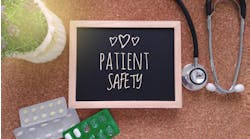Nearly eight in 10 hospital and health systems leaders reported being satisfied with their organization’s safety performance, and continuing to improve patient safety is still a high area of importance, according to the findings of a new survey.
VigiLanz, a clinical surveillance company, recently announced findings from a survey of 100 hospital and health system leaders on hospital safety challenges and improvements. With unintended harm occurring in one-third of hospital admissions, and medical errors being the third leading cause of death after heart disease and cancer, the survey aimed to take stock of current hospital safety practices, according to company officials.
Conducted in February 2020 by Sage Growth Partners, a healthcare consultancy, the independent survey asked C-suite executives, physicians, nurses, infection preventionists, pharmacists, and more about their top patient safety challenges, where the most safety improvements are occurring, if technology is enhancing patient safety, and which patient-safety improvement approaches are most successful.
Some key survey findings include:
- 79 percent of respondents said they were either satisfied or very satisfied with their hospital’s safety performance in 2019, while 21 percent said they were very or moderately dissatisfied.
- About a quarter (29 percent) said they are less confident about hospital safety than the typical consumer; 43 percent said they are more confident, and 28 percent said they feel about the same as a typical consumer.
- More than one-third (39 percent) said communication errors play the biggest role in contributing to safety problems at hospitals; 30 percent said staffing/burnout. About a quarter (24 percent) cited disparate EHRs/poor interoperability/lack of actionable data at the point of care as the biggest safety issue.
When asked to identify the top safety problems within hospitals, 28 percent of respondents selected medication errors. Other responses included hospital-acquired infections (HAIs) and hospital-acquired conditions (HACs) (26 percent), failure to report safety events in a timely manner (18 percent), and antibiotic overuse/nonoptimal use (12 percent).
However, 40 percent said medication error rates have fallen at their hospitals in the past year; only 11 percent said they increased, and 49 percent said they stayed the same.
The data revealed that 57 percent of respondents are receiving real-time alerts related to medication errors/potential errors, while 29 percent reported reducing medication errors as their organization’s top safety improvement initiative for 2020. Overall, improving patient safety ranked as hospital leaders’ third most important strategic priority, trailing only delivering high-quality care and reducing costs/increasing efficiency. While 95 percent of respondents reported that clinical surveillance solutions improve patient safety, less than one-third (29 percent) actually use them.
“As the U.S. fights the COVID-19 pandemic, hospitals face new and unprecedented challenges to keep patients safe,” said VigiLanz Chairman and CEO David Goldsteen, MD. “We are already seeing increasing adoption of technology solutions to help manage medication scarcity and use, infection control challenges, and much more, specifically pertaining to COVID-19. Hospitals are recognizing that use of technology and real-time intelligence directly correlate with patient safety and outcomes. While technology is not the only lever hospitals should be using to improve safety, it is an essential and foundational element of success.”

